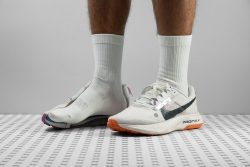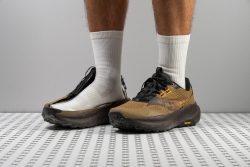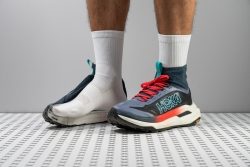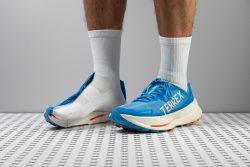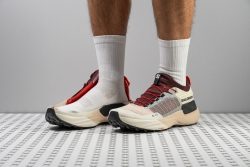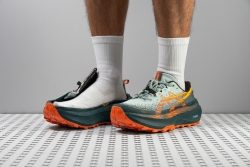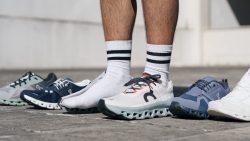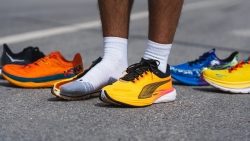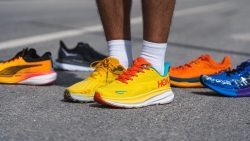7 Best Ultra Running Shoes in 2025

We buy shoes ourselves. We earn commissions when you buy through us, at no extra cost. Why trust us
Finishing an ultra is a huge feat. And behind every successful run is an excellent ultra running shoe with ample cushioning, support, and grip packed into a rugged shoe.
We know it’s a tedious job to browse through all the ultra running shoe models on the market. So, we tested them out ourselves and selected the best picks in different categories. We've pushed them on long-mileage runs and we tested them in our lab. Check out our top picks in ultra running shoes!
How we test ultra running shoes
When we assessed the ultra shoes on this list, we got down to the tiniest details to ensure they weren’t a letdown. We purchased them ourselves to prevent bias and examined them thoroughly in our independent shoe testing lab.
We also carefully follow these steps throughout our tests:
- We do multiple runs in each shoe. We report everything that we feel and encounter while wearing the shoes during our tests.
- We cut them into pieces to scrutinize their parts. We also measure 20+ different features like stack heights, energy return, shock absorption, lug thickness, outsole durability, upper breathability, and so on.
- We publish in-depth reviews that contain all our findings. Our lab data makes the shoes comparable in different features. Based on all of the tests, we select the best picks.
Best ultra running shoes overall
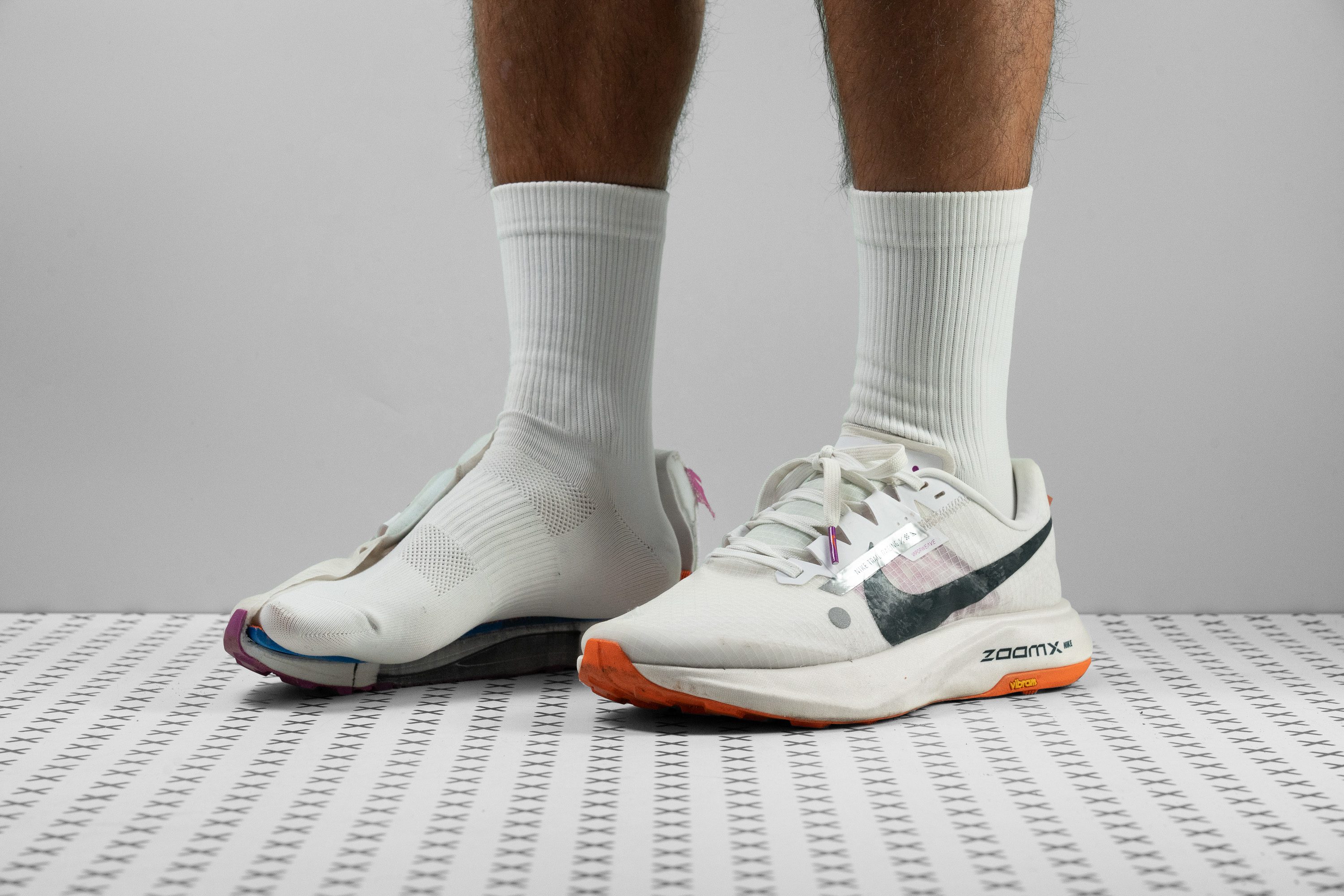



















































What makes it the best?
A cushioned, stable, responsive, and grippy ride is what we need for conquering ultras, and that’s exactly what Nike Ultrafly delivered in our runs. Our lab assessment reveals that its Vibram outsole makes it highly competitive on a variety of trails, while the ZoomX midsole blends cushioning, energy, and adaptability beautifully, supporting our legs during endless grueling miles.
The highly esteemed Vibram rubber delivers confidence-inspiring grip. It includes versatile 3.0 mm lugs, designed to go fast on mixed pavements. Its midsole sustains our power and speed, offering massive rebound of 66.2% in the heel and 68.5% in the forefoot.
With every snappy stride follows a soothing touchdown, care of the generous 36.6/24.8 mm stack offering high shock absorption of 134 SA in the heel. The forefoot measures a more modest 91 SA, which increases surface feedback so that we can maneuver through uneven paths.
To prevent fatigue, the midsole assists in stabilizing our footing so that our muscles don’t need to do extra work. It features a forked carbon plate in the midfoot and a broad 122.1/93.4 mm platform, which both help secure our strides.
However, its 10.5 oz (299g) build feels far from flying and heavy for a race shoe. Ultra runners prioritizing lightness and agility should skip the Ultrafly.
Pros
- Optimized for trail races
- Accommodates wide feet with ease
- Full-length, responsive Pebax midsole
- Equipped with a Vibram Megagrip outsole
- Ideal for heel strikers
- Offers outstanding comfort
- Remarkably stable
- Suitable for 100-mile races
Cons
- The Vaporweave upper could be more durable and breathable
- Heavier than expected even for a trail racing shoe
- The $260 price tag might be steep for some
- Limited toebox height
Ultra running shoes with the best stability
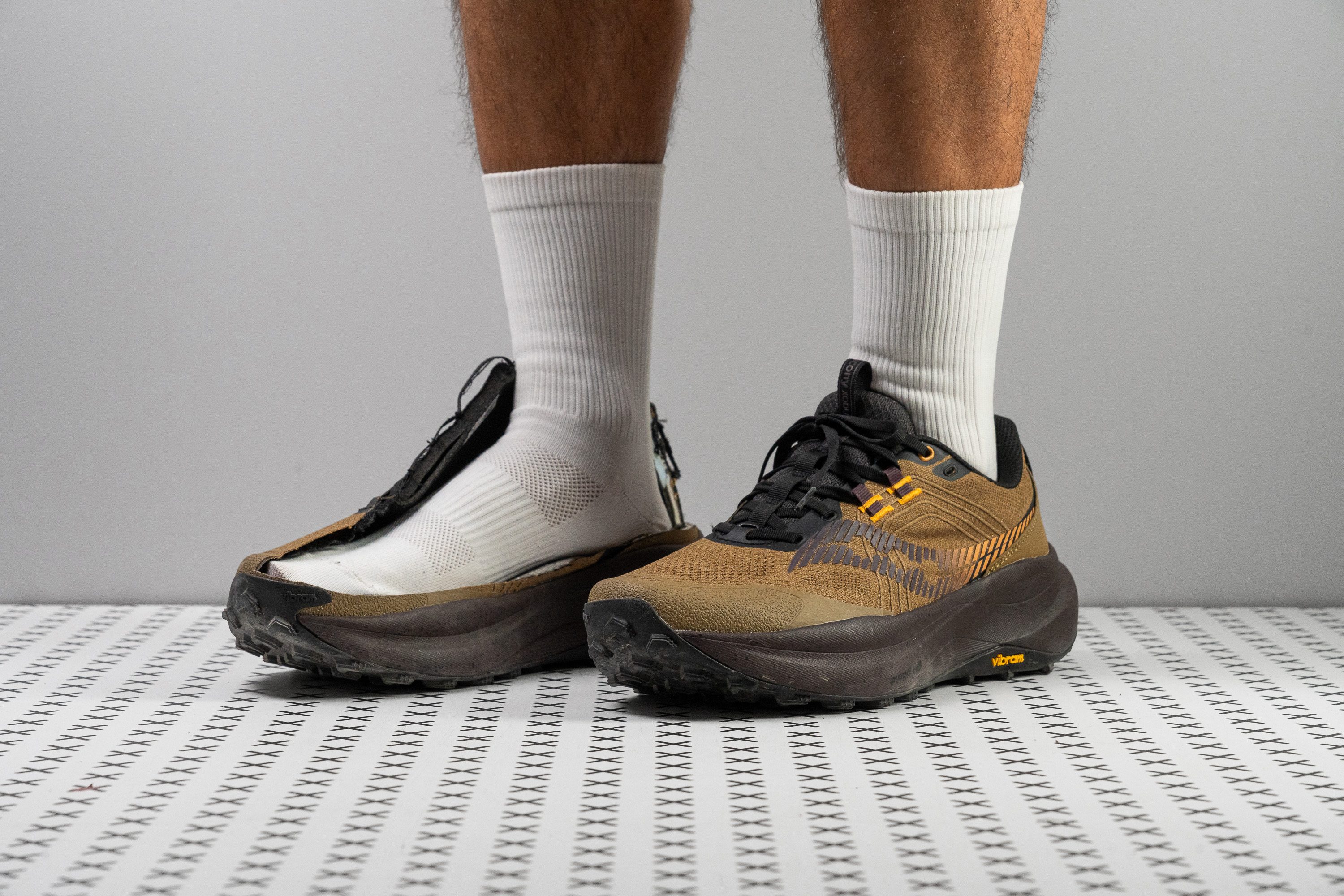
















































What makes it the best?
We ran for countless miles and lab-tested for countless hours and found the ultra-running shoe that gave us the safest and most stable feeling: the Saucony Xodus Ultra 4. Befitting of its name, it has a responsive, cushioned midsole with subtle supportive features that make endurance runs feel like a breeze!
XU4 prevents injuries and muscle fatigue through its stable base. Both wide and rigid, it keeps our feet centered and within the shoe for a well-planted sensation. It earned the maximum torsional rigidity score of 5/5 and features a spacious 116.7/97.3 mm platform.
The ride feels responsive, which has the miles melting away. Upon dissecting the shoe, the PWRRUN PB foam unfolds, returning high rebound scores of 64.9% in the heel and 72.4% in the forefoot. With every touchdown, the foam reduces impact effectively, proven by its high 127 SA shock absorption rating in both the heel and forefoot.
Underfoot, we found the Vibram Megagrip to be excellent on most terrains, further enhanced by the 3.5 mm Traction Lugs. It scored exceptionally well in our traction test at 0.72, emerging 20.0% grippier than average.
Unfortunately, those who need more toebox room to accommodate wide or swollen feet will be disappointed with its tapered design. XU4 will only feel comfortable for long mileage for those with narrow feet.
Pros
- Amazing bounce from PWRRUN PB foam
- First Xodus Ultra with a Vibram outsole
- Stable platform underfoot
- Premium PWRRUN+ insole
- Works well for hiking too
- Full-length outsole coverage
- Excellent for ultras
- Fantastic traction on easy terrain
Cons
- Weight is becoming a real problem
- Tapered toebox fit
- Small price increase
- Weak heel padding durability
Ultra running shoes with the best shock absorption
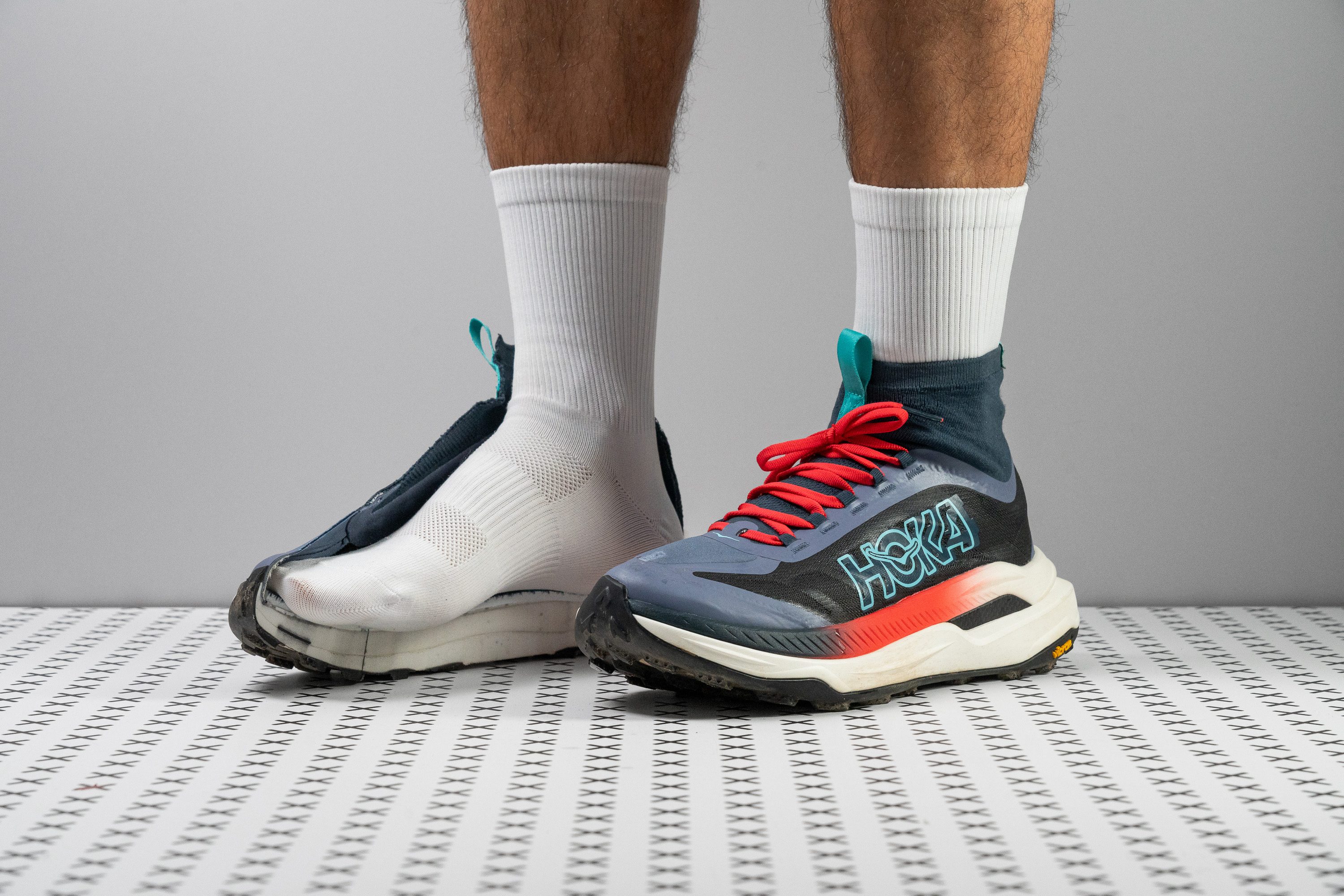


















































What makes it the best?
Overcoming ultras requires an effective impact dampener to sustain long-haul efforts, and we find the Hoka Tecton X 3 does the job exceptionally well. After lab-testing and running, we believe it offers the best shock absorption among ultra-running shoes. It provides ease not only through its decadent foam but also through its high-rebound midsole and grippy outsole, adding to our competitive advantage.
We’re spoiled with outstanding cushioning in the Tecton X 3. Standing tall at 37.8/30.9 mm, it’s highly protective and won’t collapse under heavy weight. Testing for shock absorption, we recorded 139/120 SA in the heel and forefoot, both above the 120/97 SA averages. These remarkable results assure us that it reduces leg strain, which is truly appreciated during the latter part of ultras.
Creating a more effortless ride is the responsive midsole that ignited our every stride. The shoe drives us forward with solid energy return scores of 69.9% in the heel and 70.2% in the forefoot, showing strong racer vibes.
Underfoot, the deep 4.0 mm Traction Lugs in the Vibram outsole enhanced our control through reliable traction, allowing us to move with zero hesitation.
As our feet get swollen, the shoes start to feel tight. We created a gel mold to measure its interior and confirmed that it can’t accommodate wide-footed runners.
Pros
- A true supershoe for trails
- Ultra-grippy and durable Vibram outsole
- Fantastic energy return from PEBA foam
- Versatile for both long runs and ultra races
- Stability improvements
- Shields from debris effectively
- Premium MATRYX upper
- Designed to dominate ultra-distance events
- Secure fit
Cons
- Sky-high price tag
- Heavier than the Tecton X 2
- Absolutely not for wide feet
- New ankle gaiter may not work for everyone
Ultra running shoes with the best energy return
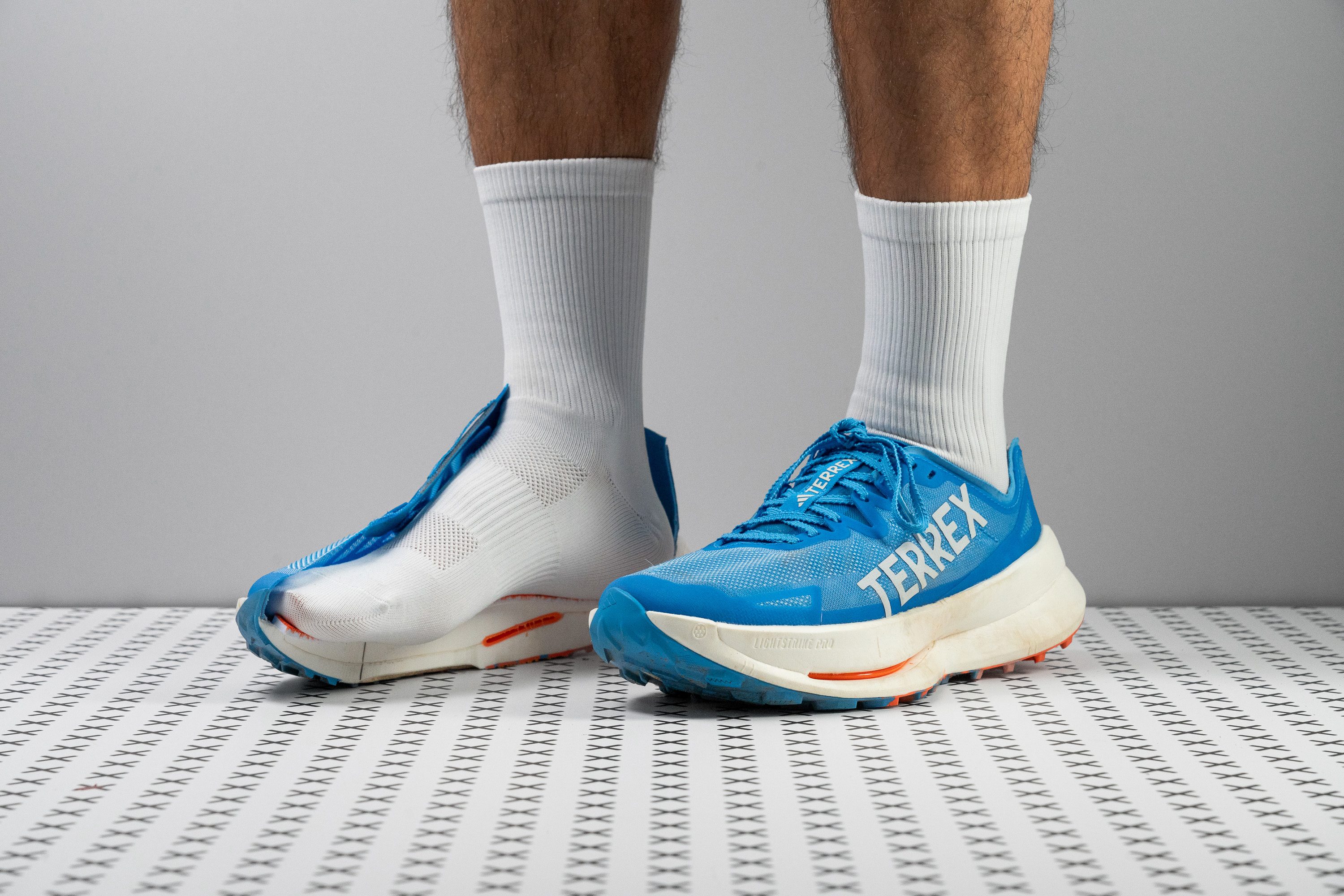


















































What makes it the best?
The Adidas Terrex Agravic Speed Ultra combines what we seek in an endurance shoe: a shock-absorbing ride, propulsion, and a stable feel. Our lab results confirm it features the magical Lightstrike Pro in the midsole and the well-crafted Continental rubber in the outsole, all in a light and explosive package, making it our ultra-running shoe with the best energy return.
Speed Ultra features a full-length premium and highly responsive foam. Our energy return test scores blew our minds and feet with 66.8% in the heel and 70.5% in the forefoot.
As a trail-ready shoe, we were surprised by its 9.2 oz (259g) weight. Being 13.5% below the average trail running shoe, it boosts our agility.
With its aggressive rocker, the midfoot rises to 38.0 mm, making it more suitable for mid-to-forefoot strikers. We felt like we could run endlessly in this pair, especially since it earned a solid 127 SA shock absorption score in the forefoot.
The midsole’s durable composition makes it feel more stable. Moreover, the 120.4 mm forefoot is ultra-wide, giving us generous space to land safely. The grippy Continental rubber also dominates the outsole and ensures our safety on a variety of surfaces we tried.
However, it has a tight toebox that may result in black toenails. Runners with wide or high-volume feet should check other pairs.
Pros
- Premium Continental rubber
- Explosive energy return
- Breathable race-ready upper
- Propulsive EnergyRods and rocker combo
- Perfect for midfoot strikers
- Explosive toe-off with extreme rocker
- Built to conquer ultra distances
- Excellent implementation of Lightstrike Pro
- Durable materials
- Excellent laces
Cons
- Unstable on technical terrain
- Heel collar design needs improvements
- Not a good pick for rearfoot strikers
- Not for wide feet
Best lightweight ultra running shoes
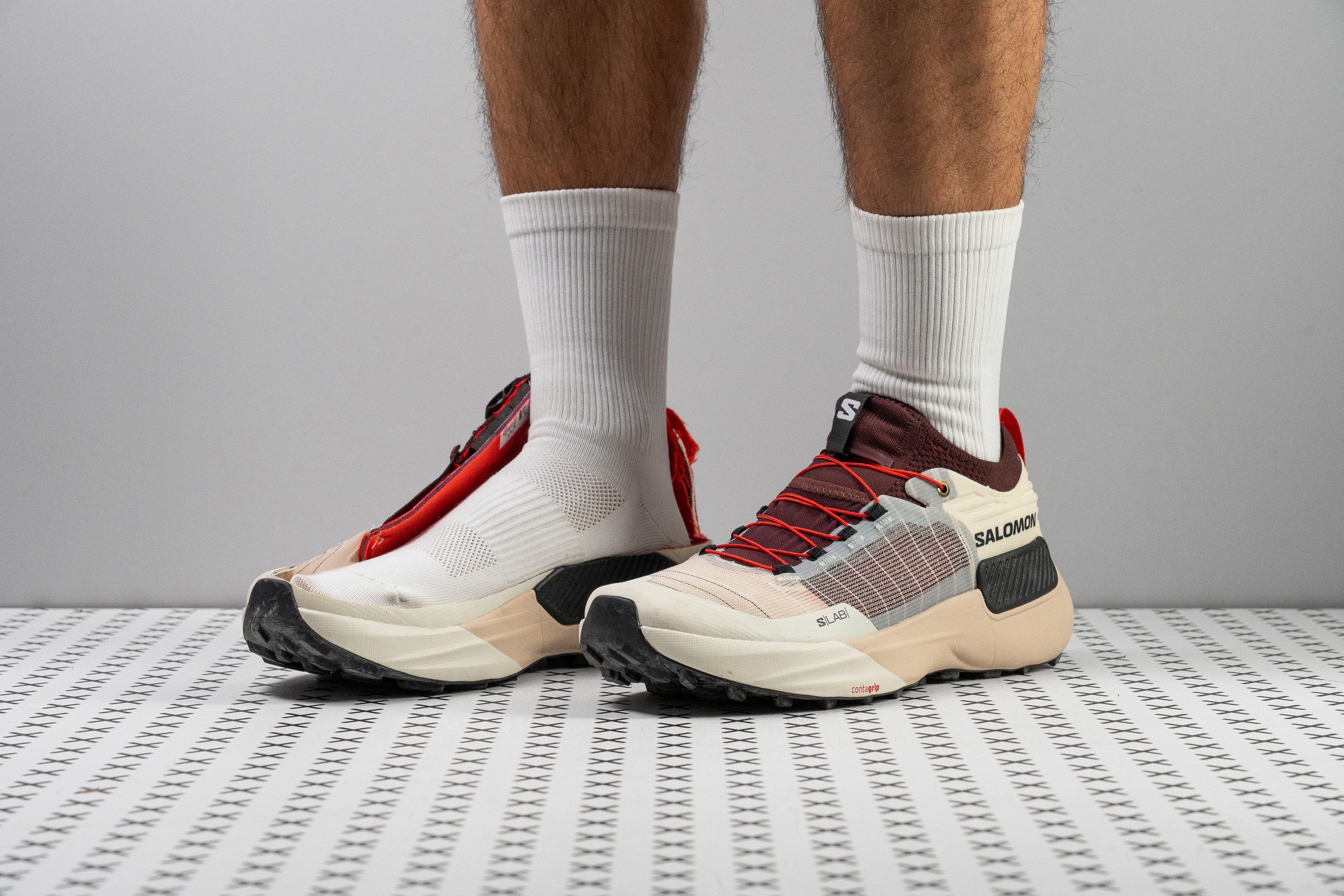
















































What makes it the best?
In our lab tests and endurance runs, we can confirm Salomon S/Lab Genesis goes the distance with its light and loose build, stable and ground-connected ride, and breathable comfort. We don’t feel our feet counting the miles because this agile shoe offers the best lightweight experience for ultra running.
S/Lab Genesis stands out with its minimal 8.8 oz (249g) figure, making it 13.8% below average. Its weightlessness is further enhanced by its flexible midsole, verified in our bend test when it emerged 4.8% more pliable than average.
We feel in complete control of our footing because the shoe’s low 31.9/24.1 mm profile offers strong ground connection. To shield us from harsh debris underfoot and enhance stability, the profeelFILM rock plate lies in the forefoot area.
The MATRYX mesh upper offers a soothing ride for long-haul efforts. In our smoke test, it impressed us with strong airflow, receiving a remarkable 4/5 in breathability, which helps avoid excessive sweating and blisters.
Unfortunately, the upper isn’t wear-resistant with its 2/5 toebox durability rating. We recommend watching out for protruding rocks or roots that may cause potential slashes.
Pros
- Exceptionally lightweight
- Premium MATRYX upper
- Excellent lockdown
- Plush, well-padded tongue
- Quick and efficient Quicklace lacing system
- Works for running and hiking
- Versatile Contagrip outsole with rock plate
- Unique aesthetics
- Feels great on fast downhills
Cons
- EVA-based midsole lacks bounce
- Expensive for the technology provided
- Upper durability could be improved
- Low shock absorption
Best ultra running shoes with a wide toebox
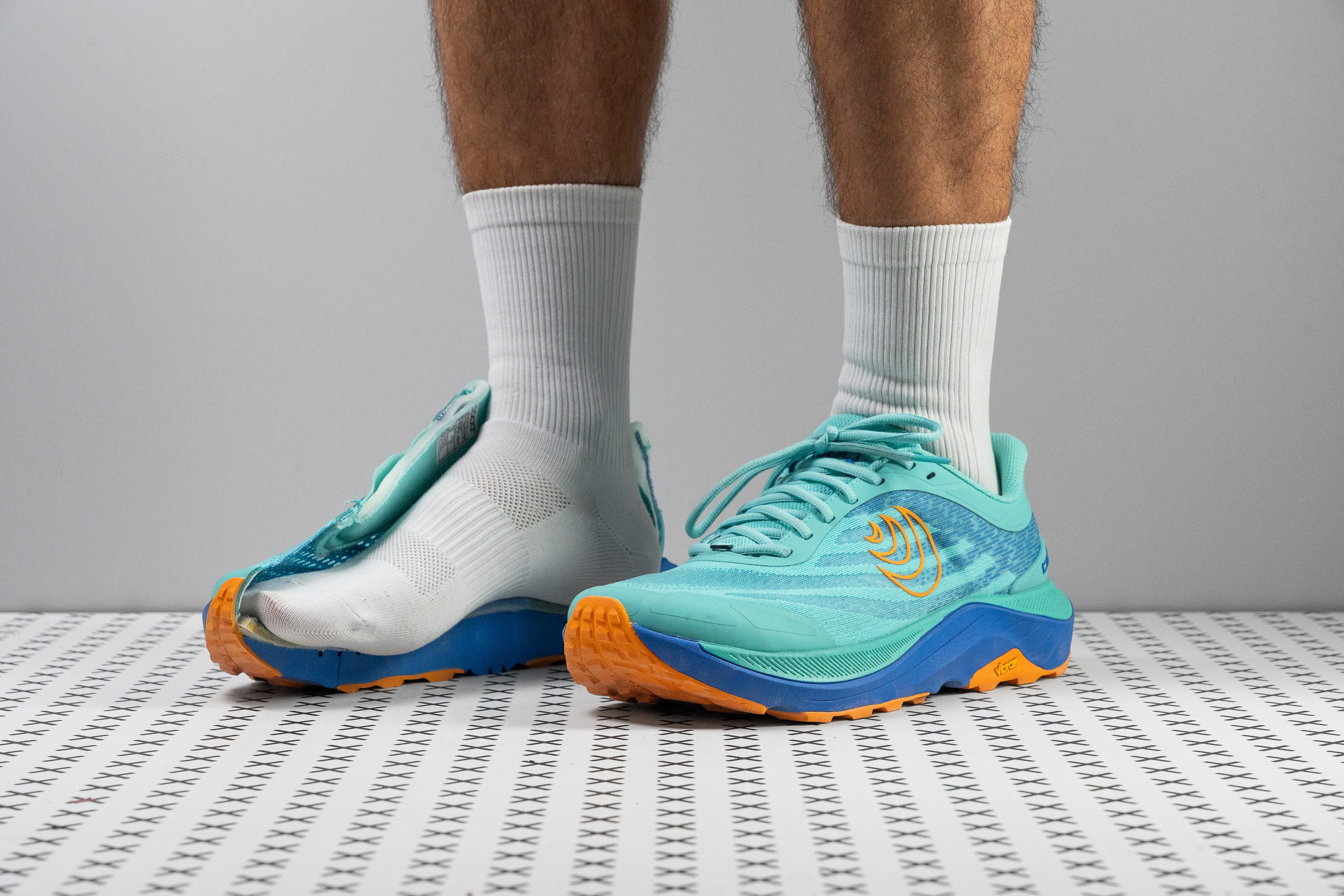












































What makes it the best?
The Topo Ultraventure 4 is built with lasting comfort in mind, and our feet couldn’t deny it! In the lab, we discovered it took care of us through its high and shock-absorbing stack, flexible midsole, and foot-shaped design. Among ultra running shoes, it’s the best with a wide toebox.
Those of us with broad or swollen feet enjoyed its accommodating fit. We created a gel mold to measure its interior, and the toebox is 80.0 mm wide and 29.7 mm tall, much more spacious than standard measurements. No matter the distance, we had no worries about cramped toes and blisters.
We measured the stack height at 35.1/28.5 mm, beating lab averages and delivering bottomless comfort. Its deeply cushioned sensation is further emphasized when we measured high shock absorption scores of 129 SA (heel) and 107 SA (forefoot). It ensures a leg-saving ride that’s highly sought after during ultras.
The midsole moves with our feet with minimal resistance, a solid achievement given its maximalist nature. Our flex test validates it’s 7.1% more adaptive than its counterparts.
Because of the shoe’s moderate 6.6 mm drop, we encourage heel strikers to find a steeper shoe that caters to their biomechanics. Its narrow 87.8 mm heel also proves it’s not meant for rear strikers.
Pros
- Extra-roomy toebox
- Hardwearing Vibram outsole
- More flexible and comfortable than version 3
- Ideal for midfoot strikers
- Can handle ultra races
- Plush tongue improves comfort
- Excellent stability in the forefoot area
- Good lockdown with no tongue movement
Cons
- Not for narrow-footed runners
- Midsole lacks energy return
- No reflective elements
- Unstable heel
Ultra running shoes with the best traction
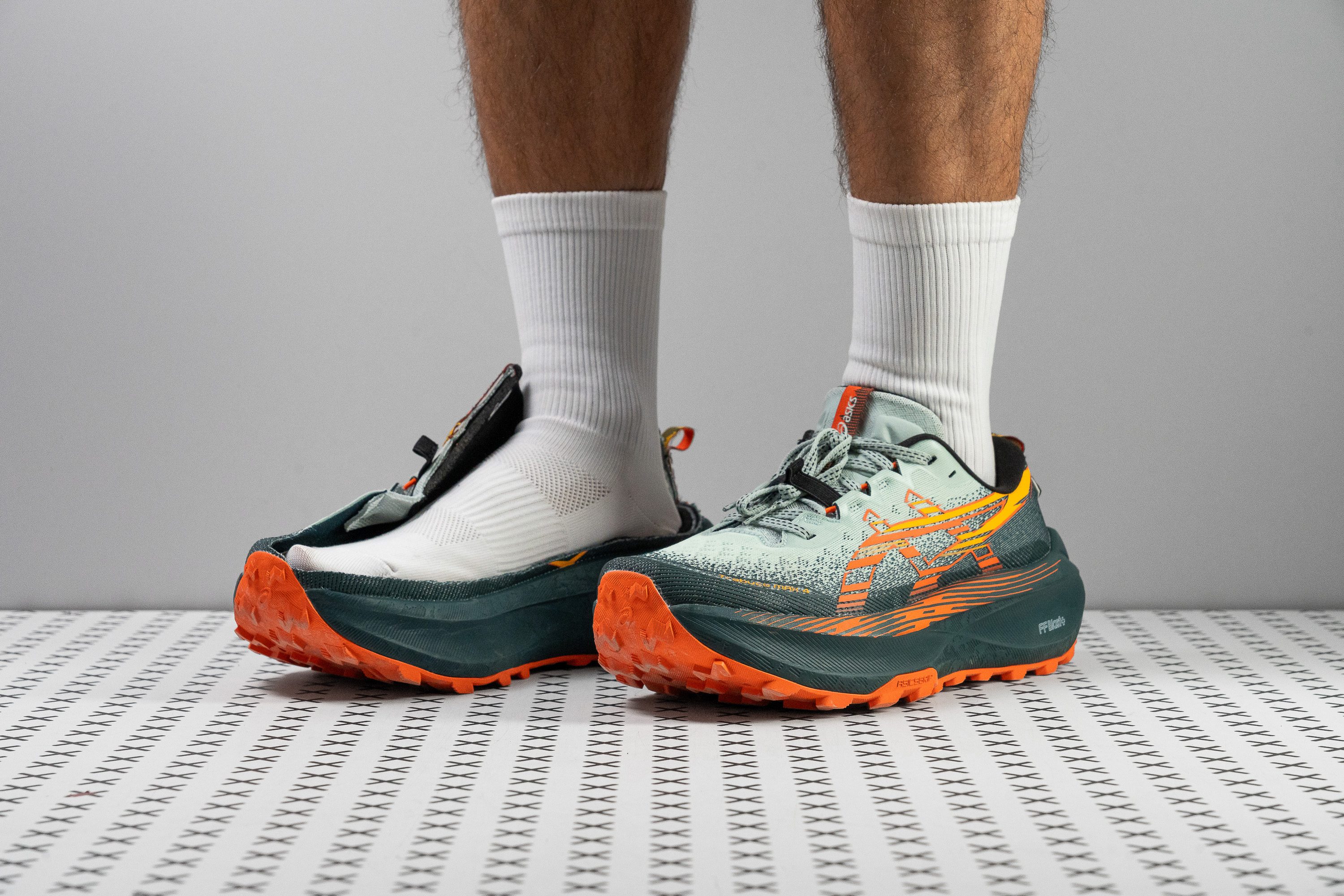
















































What makes it the best?
During our prolonged and demanding efforts with the top ultra-running shoes, the ASICS Trabuco Max 4 excels with its plush comfort and controlled footing. It's highly cushioned, with a stable ride and a dependable outsole for various terrains. Ultimately, lab results show it stands out for its traction in this category.
We immediately evaluated the ASICSGRIP rubber in our traction test, and it returned a mind-blowing result of 0.81, making it 35.0% grippier than average. It features 3.1 mm lugs, which are perfect for smoother trails and ultra settings. For the occasional technical sections, the M-shaped and chevron-shaped lugs hold ground effectively.
Equipped with FF Blast+ foam, the Trabuco Max 4 delivers superior cushioning and protection. Its 39.3/33.2 mm stack height ensures zero ground feel, with strong shock absorption scores of 125/127 SA reducing the impact of landings.
To balance out the shoe’s height and softness, it features tall sidewalls and a structured midsole. It’s impossible to twist our ankles in this shoe, with its maximum 5/5 torsional rigidity score in our assessment.
However, its focus on cushioning and support compromised agility. With its 11.0 oz (312g) figure, it feels bulky for faster efforts.
Pros
- Huge forefoot cushioning
- Full-length ASICSGRIP rubber
- Extremely stable despite its height
- Can handle any distance
- Handy tongue loop keeps laces quiet
- Well-padded, comfortable tongue
- Rockered shape for easy transitions
- Ideal for flat, easy trails
Cons
- Not ideal for heel strikers
- Questionable outsole durability
- Heavy build
- Tapered toebox
This guide applies to average trail runners and their needs. Because of this, we recommend cushioned shoes, mid-to-high heel drop, and so on. Of course, there are runners who run ultras in less-cushioned running shoes with a low heel to toe drop. However, that’s mostly reserved for more experienced runners who are well aware of the niche shoe categories and what they do for the legs and feet.
We will mention this category but will not focus on it.
What to look for in running shoes for ultras
We recommend looking for 5 things:
- Cozy fit that allows some swelling that will inevitably happen but also offers a superb lockdown
- Average-to-high breathability
- Durable toebox and outsole
- Avoiding zero or low heel drop, but looking for mid-range or high drop (higher than 5mm)
- Superb cushioning: a lot of it (at least 30mm at the heel) + responsive
- Lugs and outsole thread patterns adequate for the terrain in question
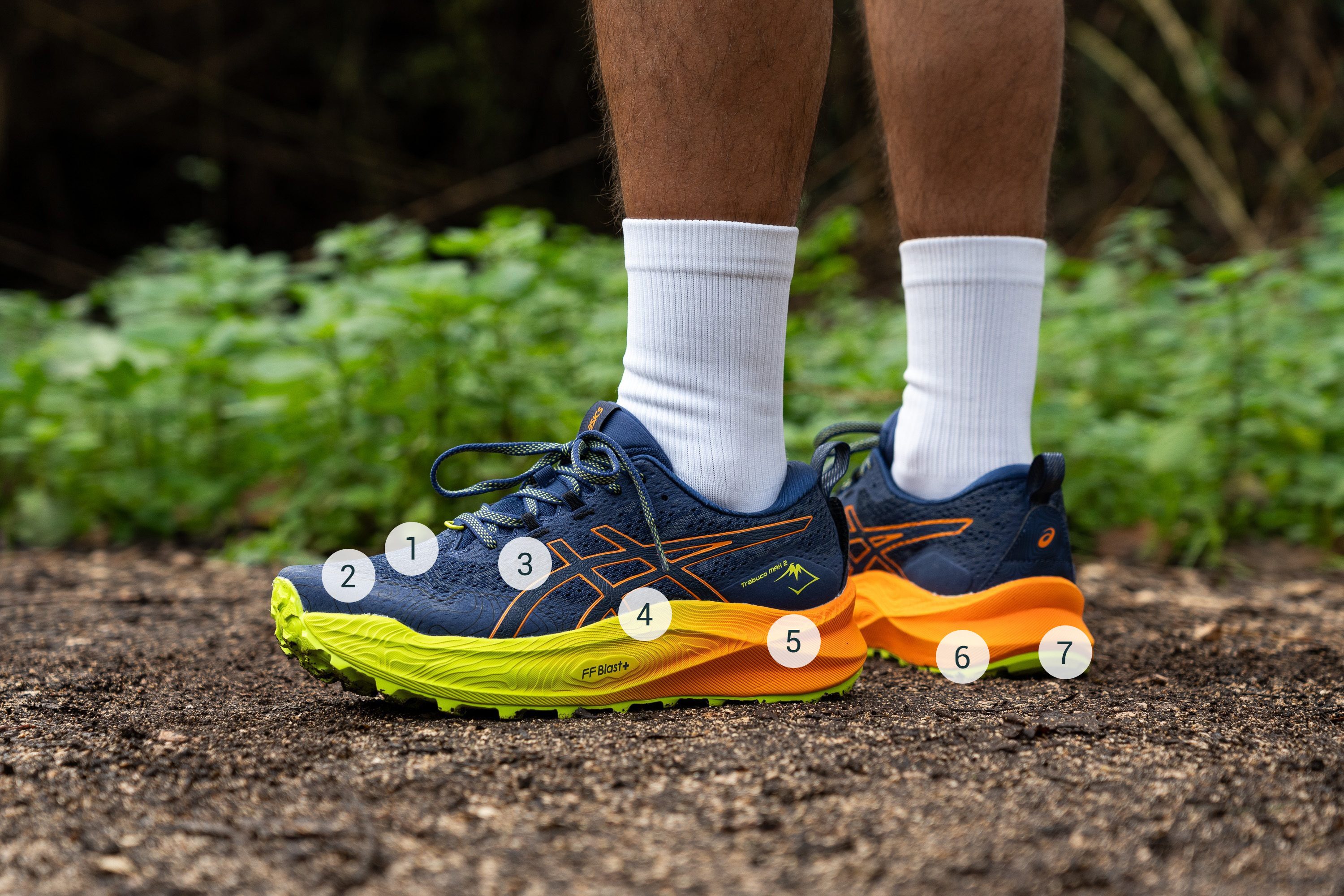
WANTED: cushioning
How cushioned should the ultra running shoes be? We recommend at least 30mm at the heel. This is, of course, based on average runners and not minimalist/barefoot enthusiasts who prefer the ground feel, even after 50k.
Stack height of ultra running shoes
In our lab, we measure the stack heights according to the guidelines from WorldAthletics. For this to be properly done, the shoe has to be cut in half which is, of course, what we also do.

Now we know that just because the shoe is cushioned does not mean that it’s comfortable or responsive.
Energy return and shock absorption
Some foams are soft but dull, or squishy, or very responsive! Let's have a look at those numbers.
Testing the energy return and shock absorption of ultra running shoes in RunRepeat lab
Here's why these 2 features are so important: high energy return means that the midsole is efficient at bouncing back, which means it's propeling you forward so your legs don't have to work as much; and high shock absorption means that the midsole absorbss a lot of the impact at the landing and, therefore, less stress is sent towards your legs.
The highest energy return is usually found in race shoes, and the lowest in running shoes for daily abuse (slower runs). This is justified because daily trainers prioritize durability and lower price.
Weight of ultra running shoes
Others can be too firm for your feet. Of course, more foam usually means more weight. It’s a balance we’re looking for.

Heavier shoes slow us down but also bring more impact protection, so it’s about weighing your priorities and options.
Choose a higher heel drop for ultra runs
Now that we’ve covered the stack heights, it’s impossible to skip the heel to toe drop. Runners who land at the forefoot or midfoot tend to choose lower heel drop, while heel-striking runners go for a high heel drop.
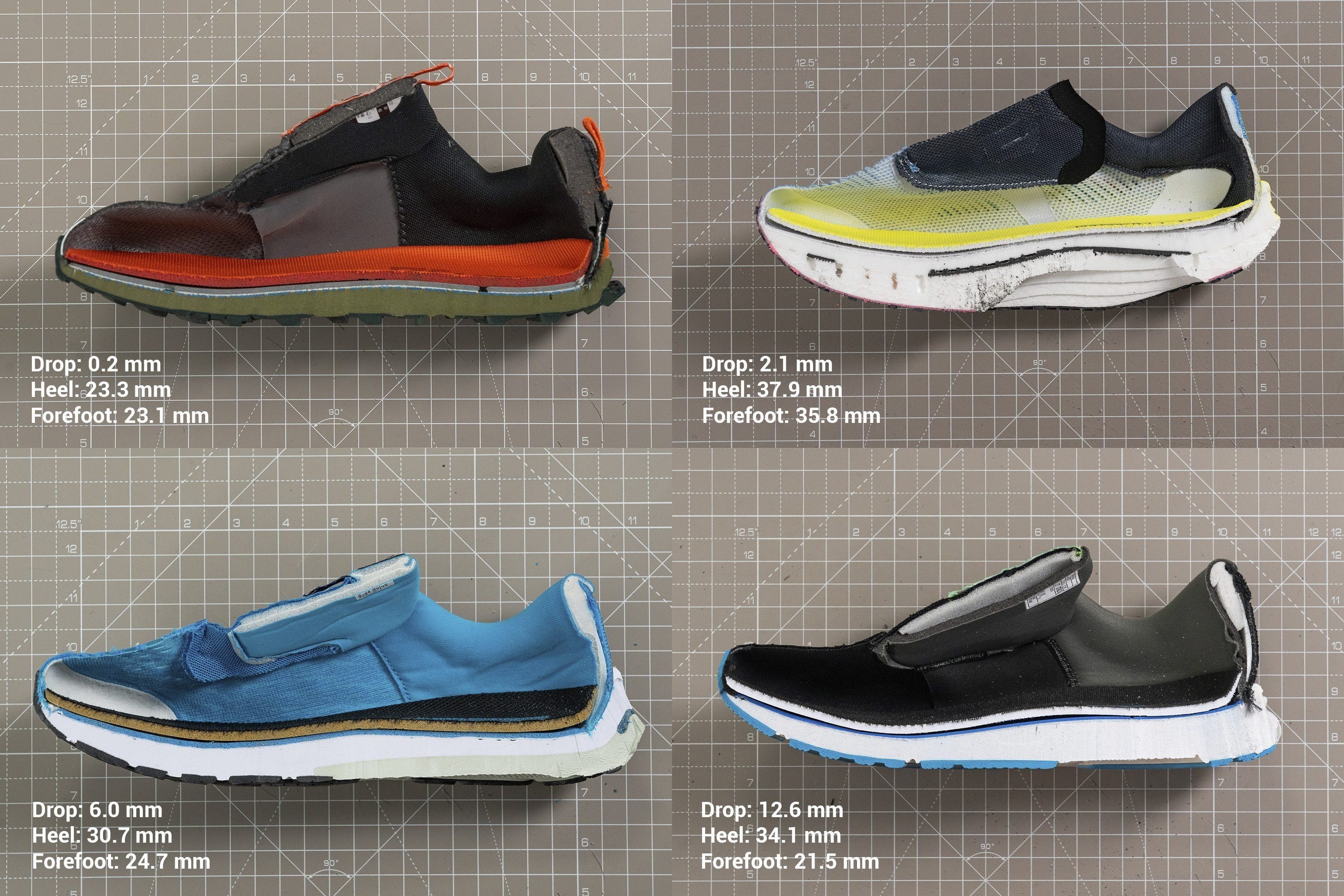
During an ultra, our feet get tired and might appreciate any help they can get. Even forefoot strikers end up striking at the heel due to fatigue. So, some runners decide to run in a higher-drop shoe. As always, best to learn what suits you best while training for an ultra.
|
To learn more (or everything that matters) about the heel drop, read our very in-depth Ultimate guide on heel to toe drop. |
Best upper for ultra running is the breathable one
First, it should be breathable. In our shoe lab, we test breathability by pumping the smoke into the shoe and watching where the smoke comes out and at which pace. Based on this, we assign a breathability rating on a 1-5 scale, where 1 is the least breathable.
Of course, if you’re running in very hot weather, look for uppers rated with 5/5 or 4/5. If not that hot, 3/5 could also work.
To understand this better, we look at the uppers under the microscope.
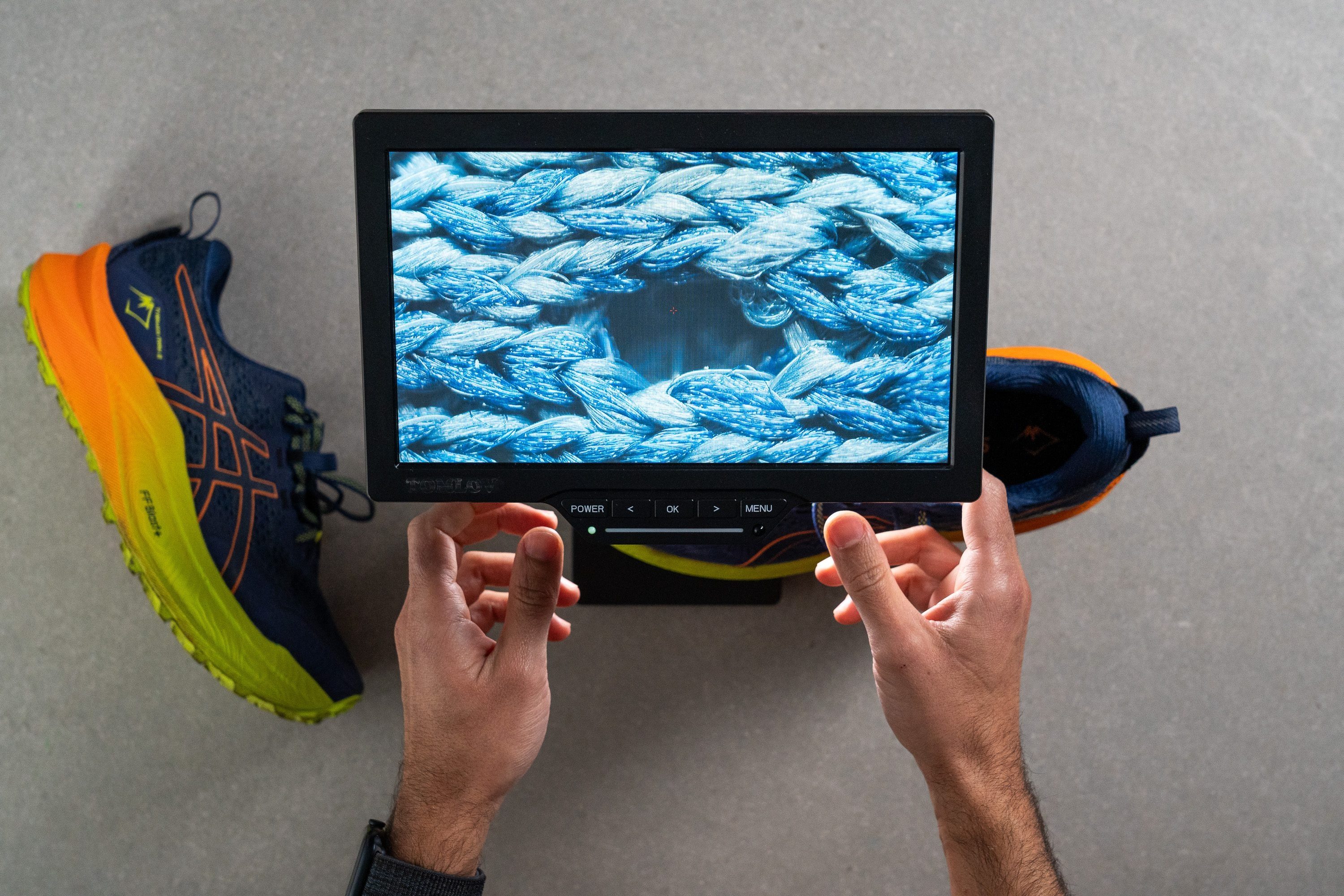
It’s very interesting to see how the threads are intertwined, where ventilation holes are how big they are, whether the structure is loose or tight, etc.
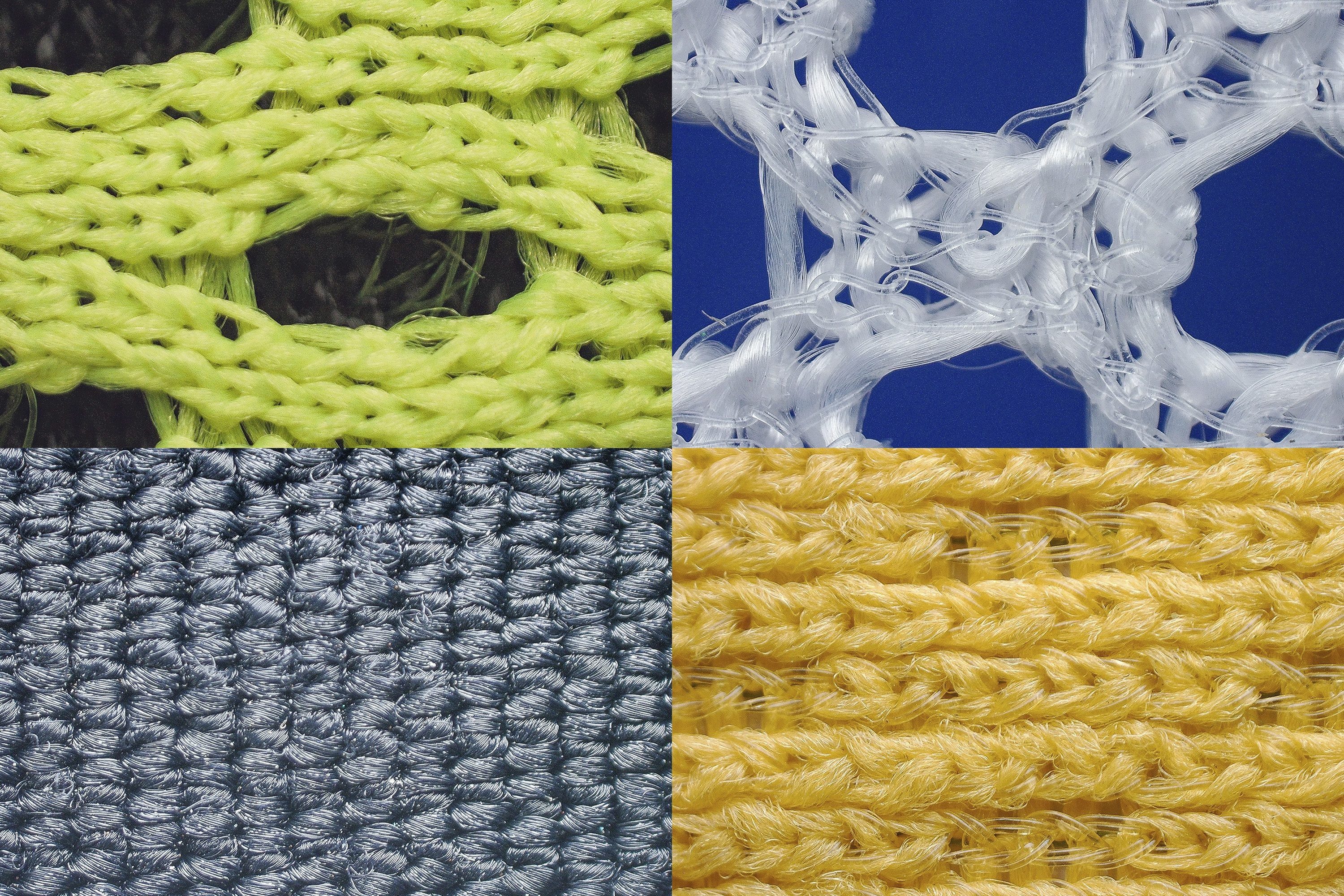
|
If you’d like to go down the rabbit hole in this running-shoe-upper world, we highly recommend reading our guide: Running shoe upper: how to choose the best one for your needs. |
Dealing with swelling during ultra races
Our feet swell even when just spending the day regularly, at work, with our families, etc. And they swell even more when doing hard work, like an ultra race.
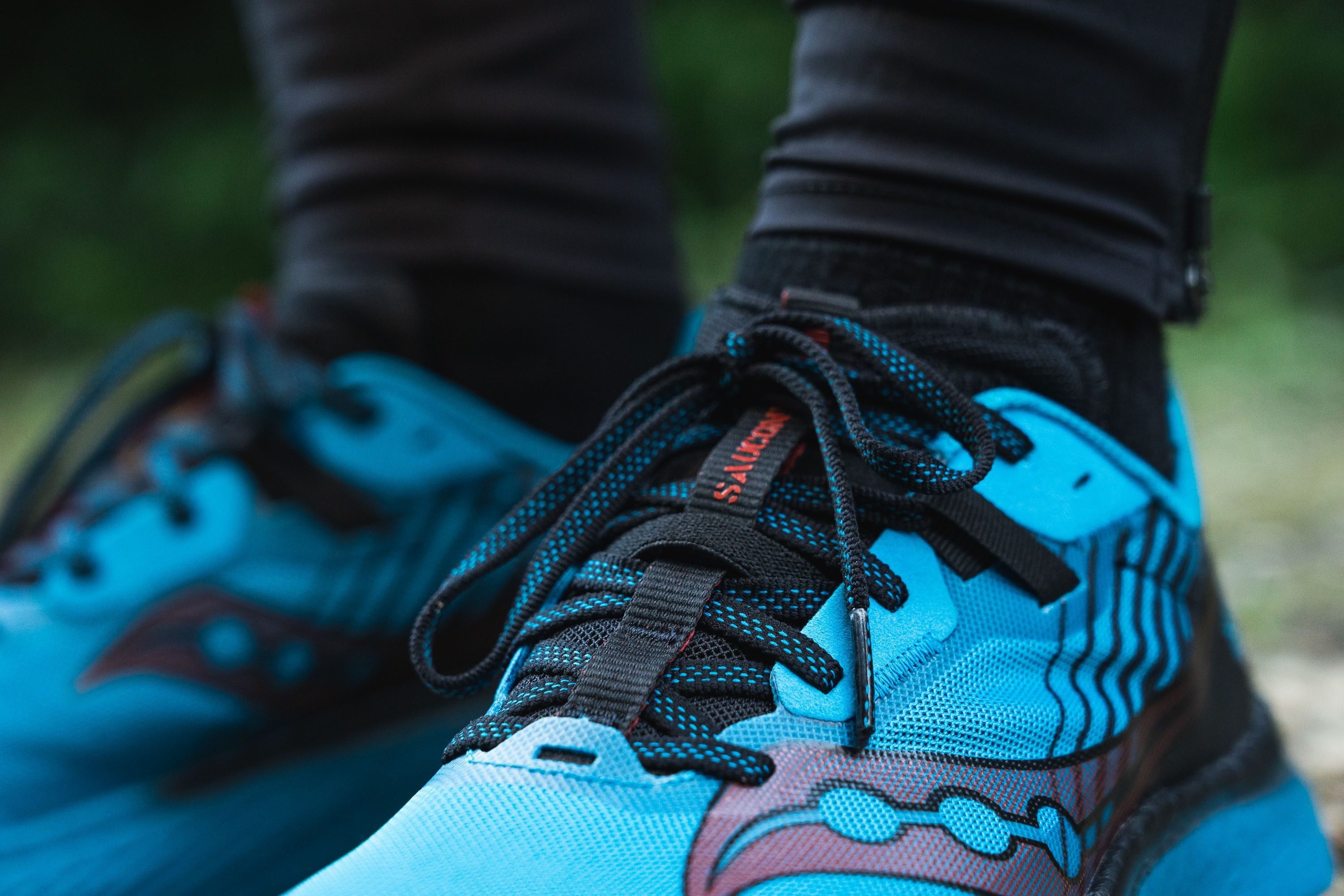
Because of this, it’s important to choose a roomy shoe: one that will allow your feet to swell without creating hotspots and blisters, while at the same time providing a great lockdown.

In most cases, we worry about cramping our toes as that can lead to bleeding, blisters, black toenails, and even worse. In the lab, we measure the width of the shoe in 2 places: where it’s the widest and at the big toe.
To measure the width of the shoe, we first have to make a gel mold of the shoe's interior. This allows us to get exact inner measurements and not measure the width on the outside (which would include the thickness of the upper)
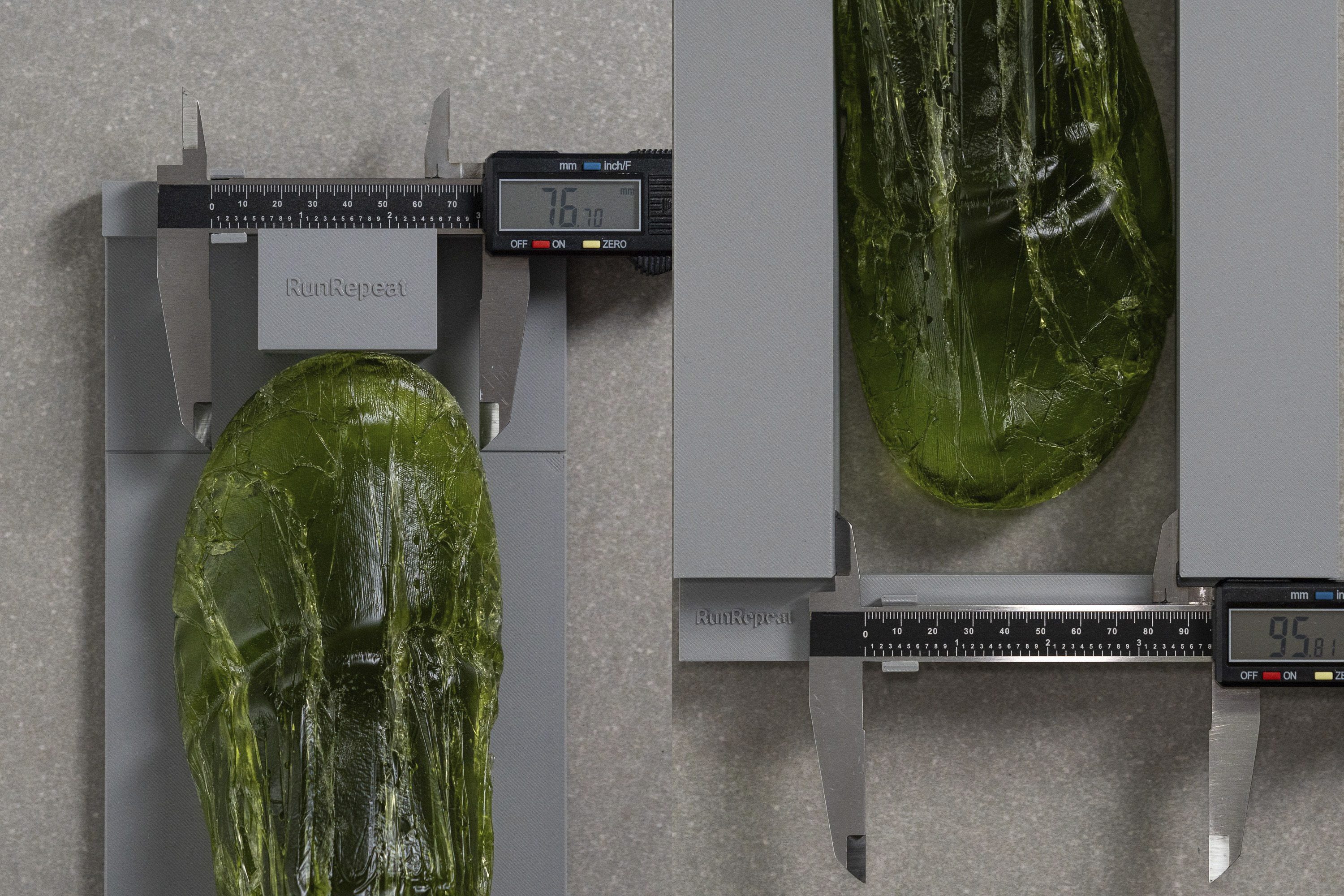
The big-toe measurement allows us to understand how much the toebox tapers or how pointy it is. This is important because we all have differently shaped toes and want to find a shoe that fits us perfectly.
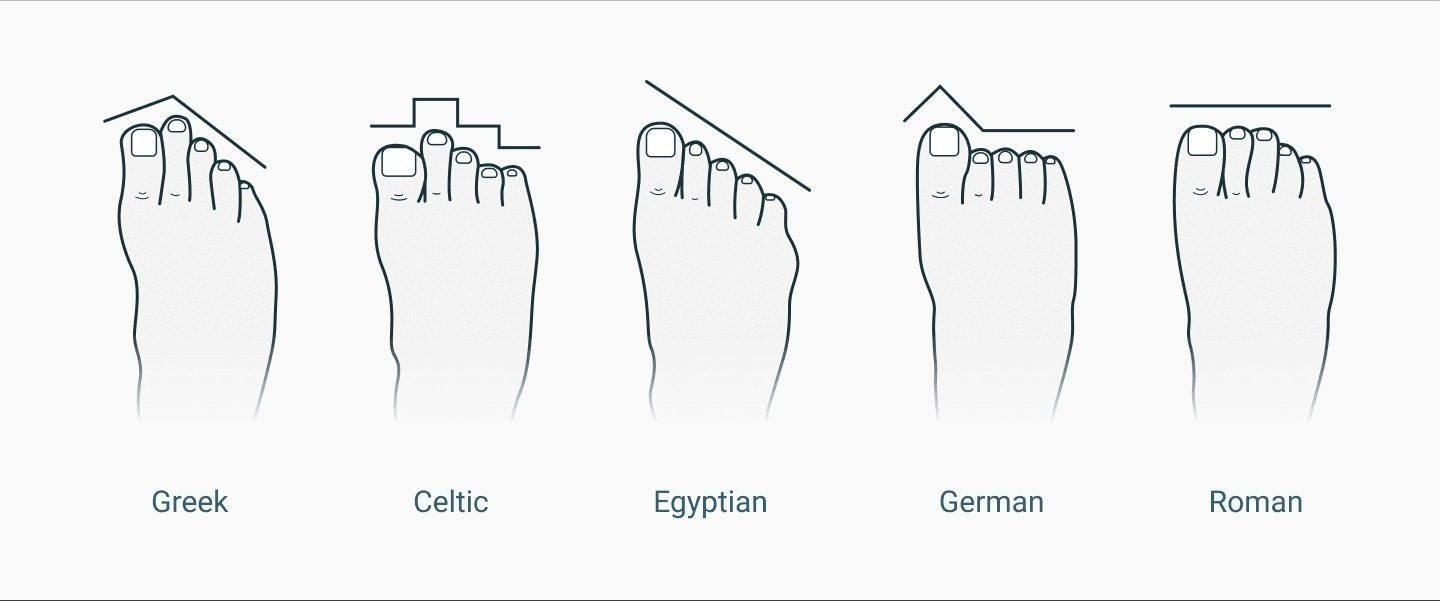
|
Some runners whose feet swell up a lot deal with it by changing the shoes to a wider fit or sizing up, some time mid-race. |
Below, you can find ultra running shoes that are the widest in these 2 areas. These lists are automatically updated with every ultra running shoe we review!
It's also important to consider the toebox height. Especially when running on steep downhills, the upper can press on our toes and toenails. To avoid black toenails or blisters, consider higher toeboxes.
Upper and outsole durability lab tests
In ultras, durability matters much more than in short distances. The shoe really has to endure and we throw everything at them: mud, obstacles, debris, sharp rocks, water. Because of this, we recommend finding running shoes with very durable toeboxes and outsoles.
To test the durability of both, we use a dremel. We press it against the surface, always using the same force, RPMs and duration.
Testing the durability of the toebox in RunRepeat lab
Once the damage is done, we assess it and rate on a 1-5 scale, where 1 is the least durable and 5 the most durable.
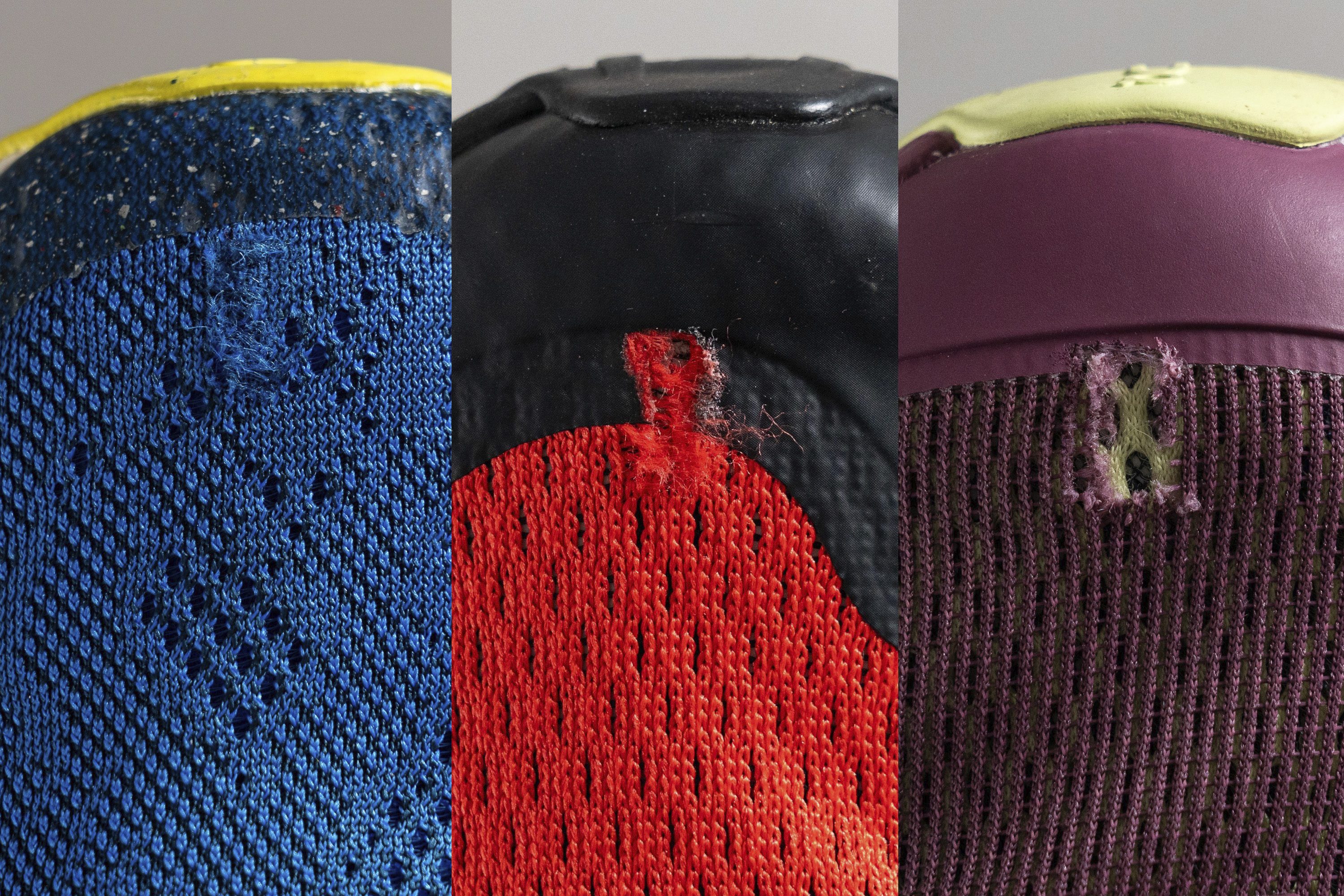
Outsole durability test performed in RunRepeat lab
When it comes to the damage done on the outsole, we’re able to precisely measure the depth of the dent with a tire tread gauge.

Deeper dents tell us that the outsole is less durable and vice versa.
Grip and lug depth in ultra running shoes
Before running an ultra, it’s best to learn what type of terrain awaits you. Is it mostly a hard-packed trail, or are there any rocky sections, maybe it’s a fast soft-ground single track or a very muddy trail.

There are 3 things that we can look at when it comes to the grip. First, the thread pattern. Then, the lug depth. Finally, the hardness of the rubber.
When it comes to the thread patterns, we recommend:
- A lot of closely spaced multidirectional lugs if you’re covering a bit of everything on varying terrain (both uphill and downhill)
- Deeper lugs (4mm and above) if you’re running on soft wet ground like snow or mud
- Widely spaced lugs if it’s mostly mud as the distance between the lugs allows mud shedding
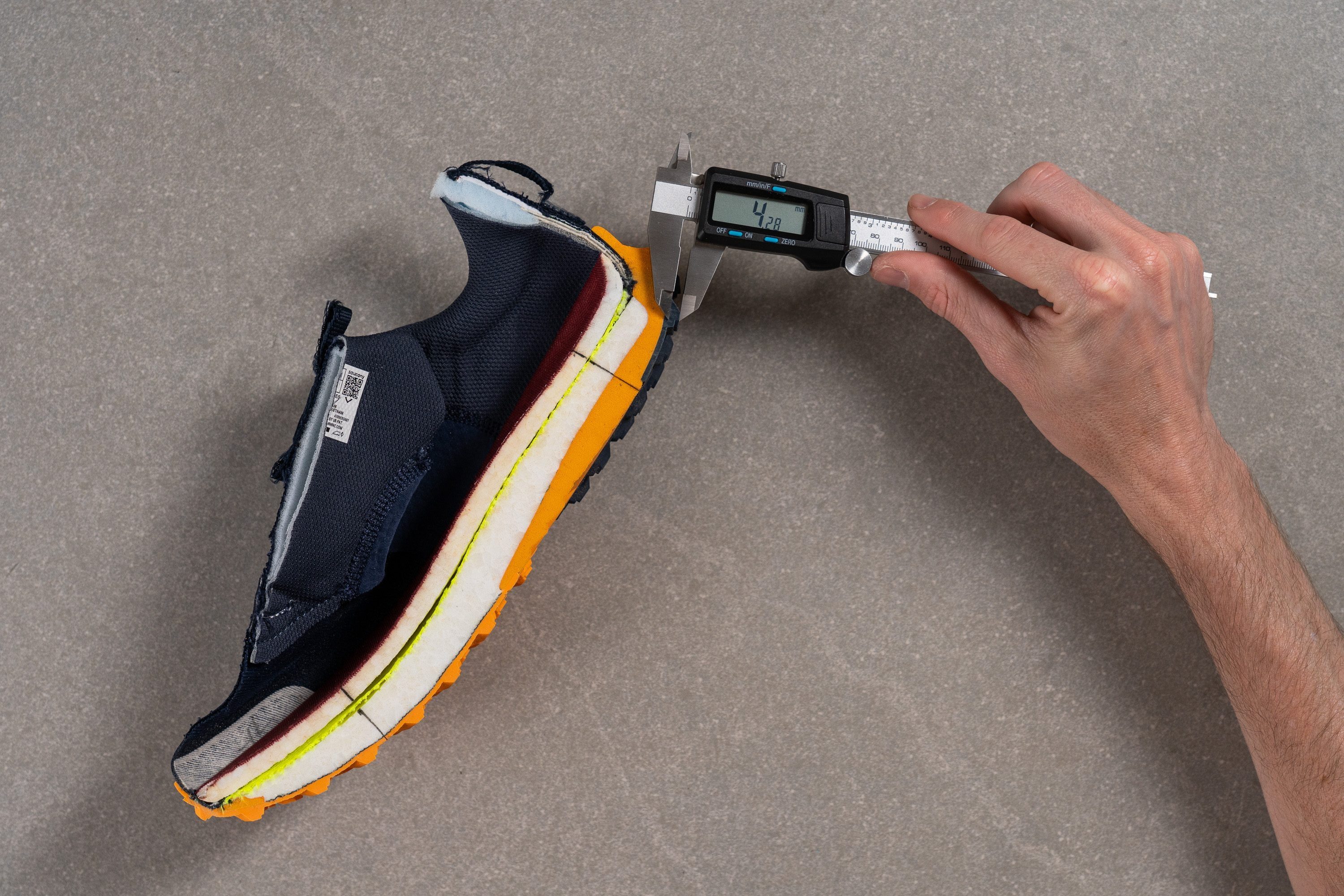
Hybrid shoes usually have shallower lugs which is why they work well for road-to-trail adventures or very light, easy trail terrain that maybe even includes some roads. Here, we’re thinking of anything below 3mm.

Versatile shoes used for moderate terrain usually have lugs that are 3-4mm deep. Keep in mind that there are other things that affect the overall performance which is why very bulky shoes don’t work well on technical terrain even if they have deep lugs, or why some very aggressive stiff shoes with somewhat shallower lugs excel on technical terrain. There is some overlap, for sure!
For muddy trails, we recommend lugs that are at least 4mm deep.
Changing the shoes mid-race
Some runners change their shoes mid-race. This happens for many reasons:
- their feet got swollen a lot and now they need something with a wider/longer fit;
- some critical parts got destroyed, like an eyelet, lugs, upper;
- their feet got too wet and the shoes can’t dry easily so they jump into the dry spare pair;
- they had to treat a wound or a blister with a lot of tape which made the feet wider;
- their feet are too tired and need a bit more cushioning now or a higher heel drop; and so on.
It’s always good to have a spare pair ready, but what features it should have (the same pair as the one you started the race in, or the one that’s a little wider, more cushioned, higher heel drop, etc.) that’s on you to find out while training for an ultra.
How socks can help?
From our experience, it’s best to use socks that are not made of cotton. They have no moisture-wicking properties, they do not dry quickly.
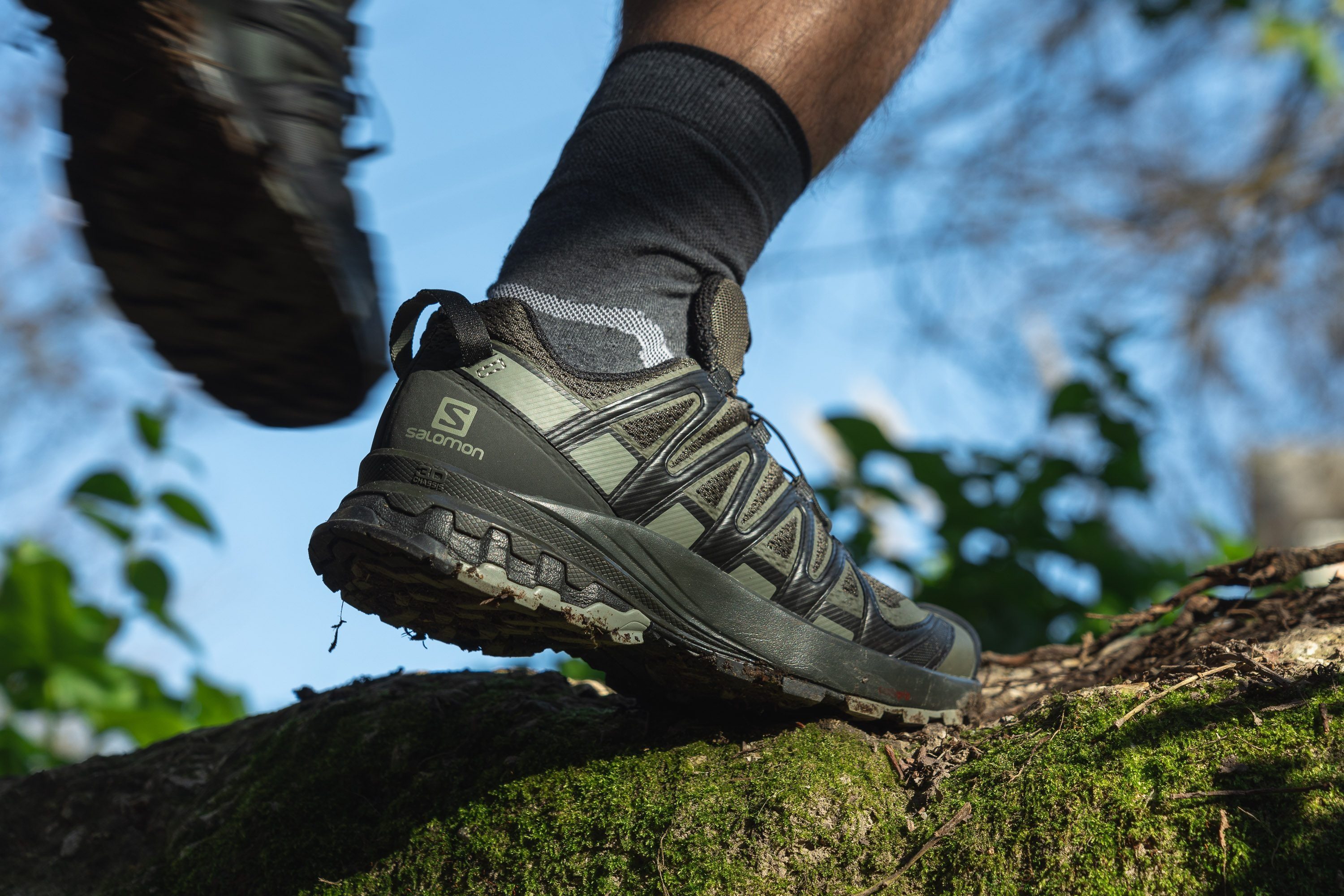
Many prefer wool or bamboo socks. Compression socks work wonders for some of us, but we don’t recommend trying them at the ultra race first. It's best to test them in advance. You might enjoy the compression only at the feet, while other runners prefer knee-high compression socks or even compression shorts.
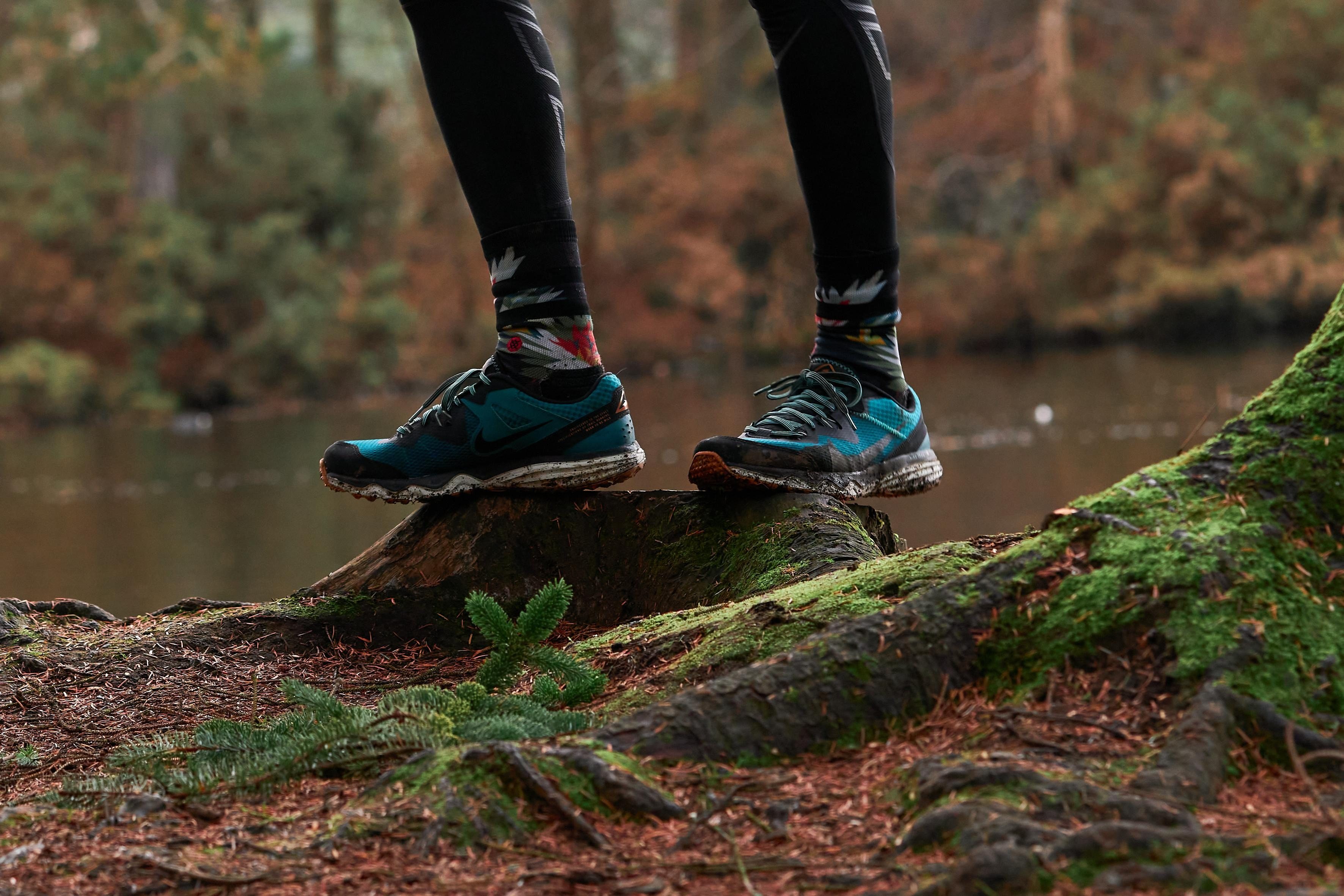
The important thing is that socks should not create bumps or layers that would irritate your feet. They should fit perfectly. You might appreciate a change of socks mid-race, maybe even more than once, so best to pack a few spares!
Injinji socks have been gaining popularity. They might look odd with every finger having its own “sock” but they do the job well and we see them more and more on racers’ feet.

